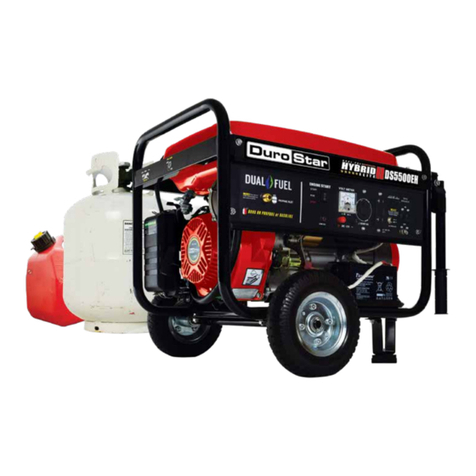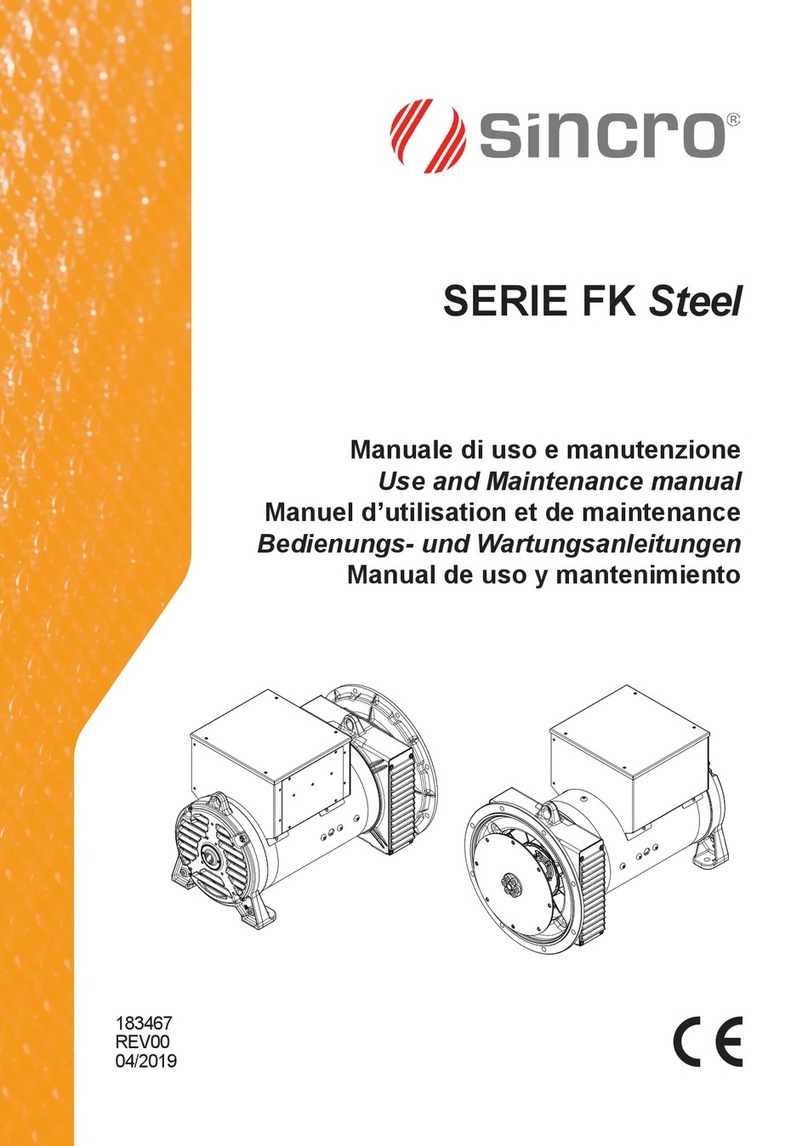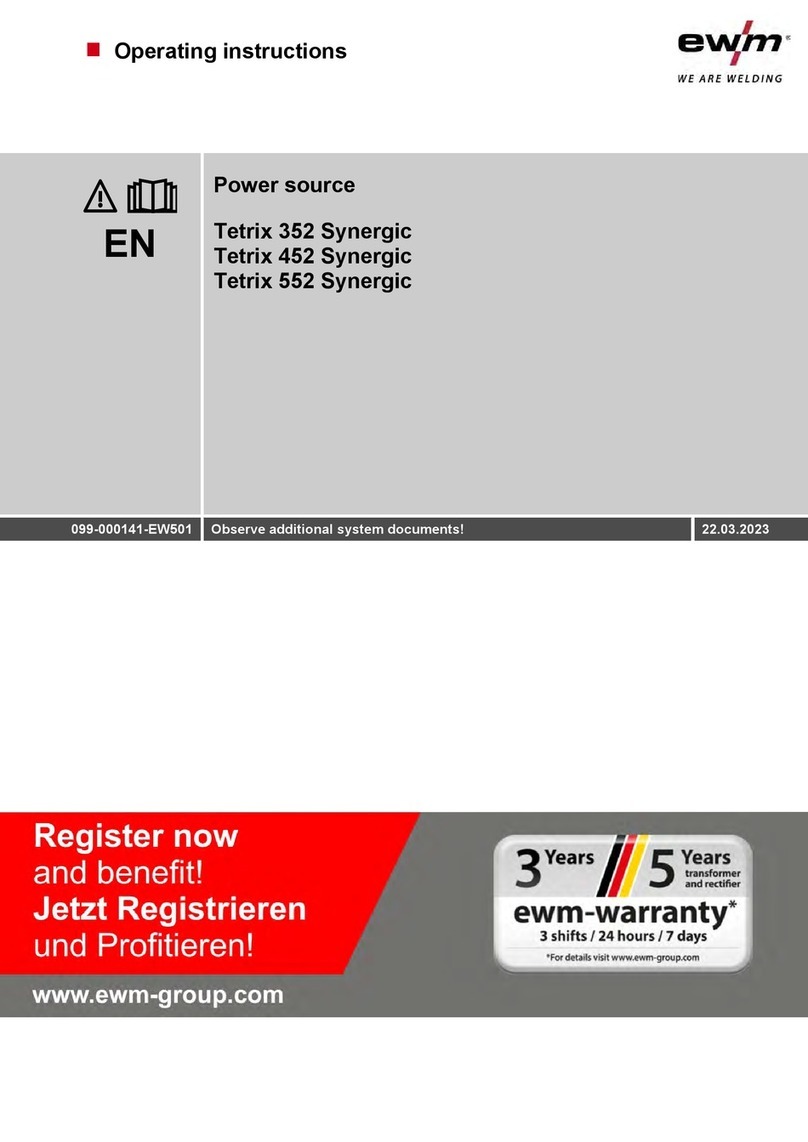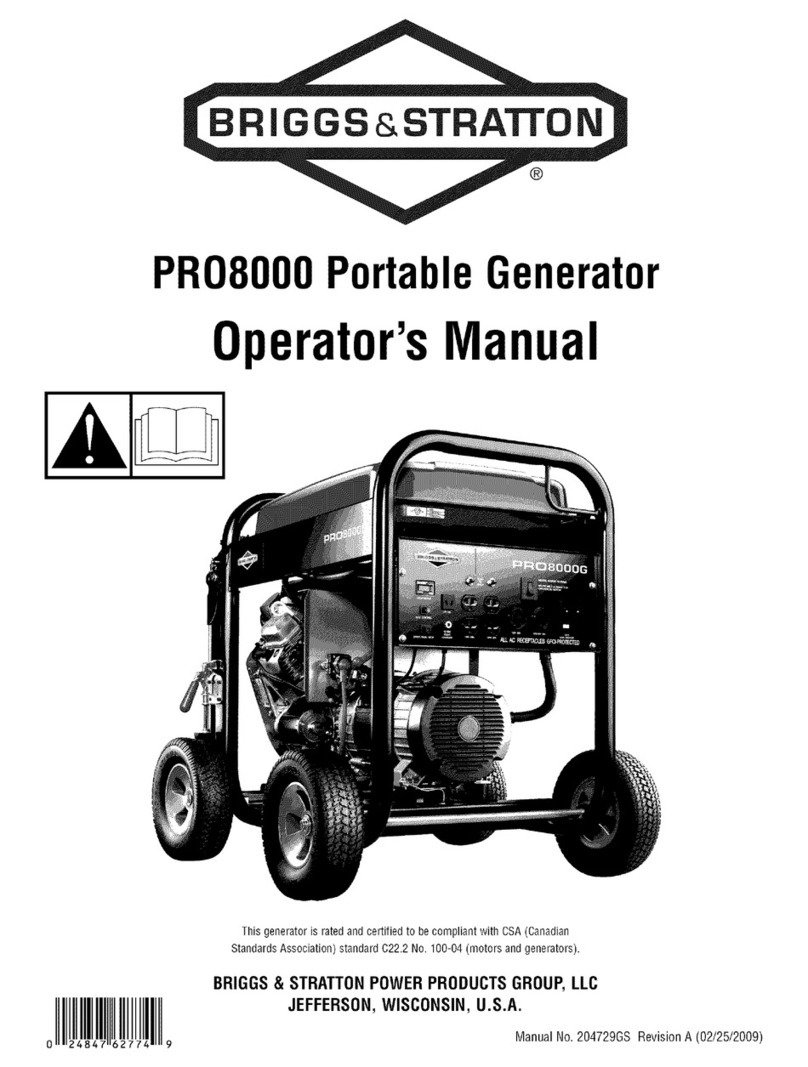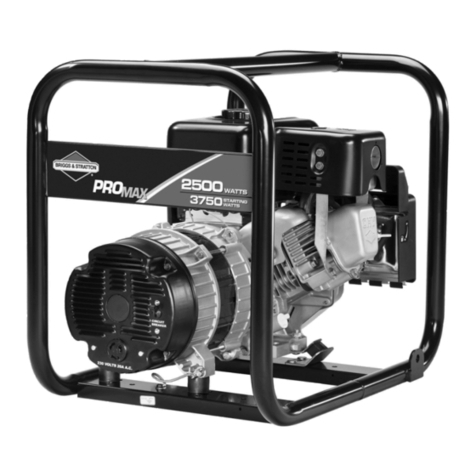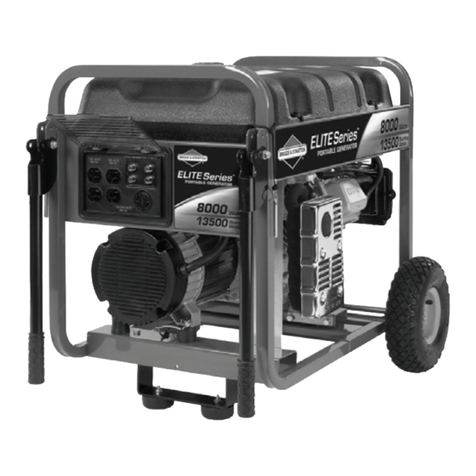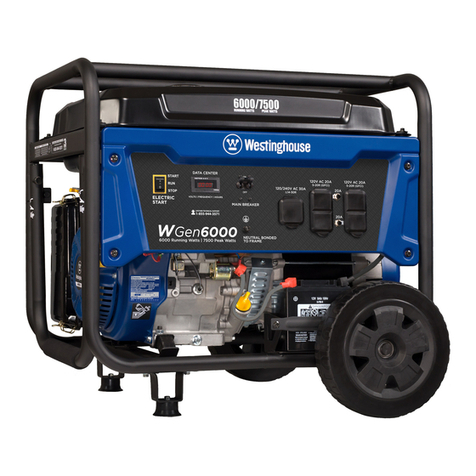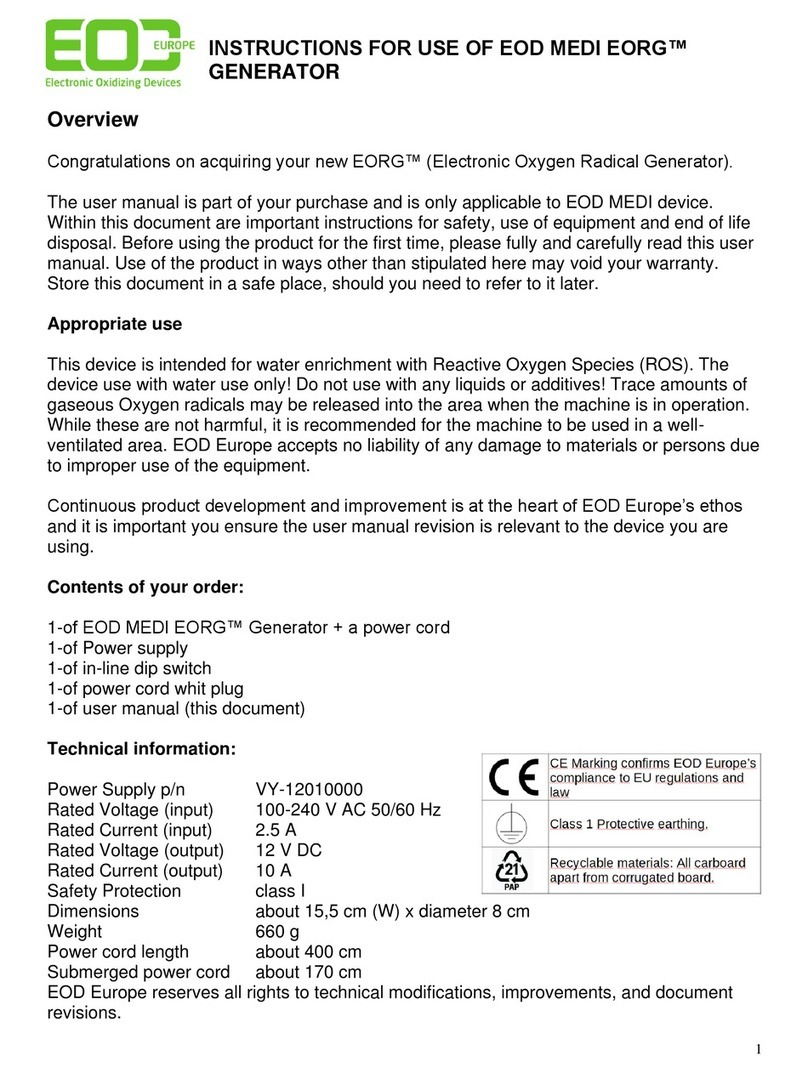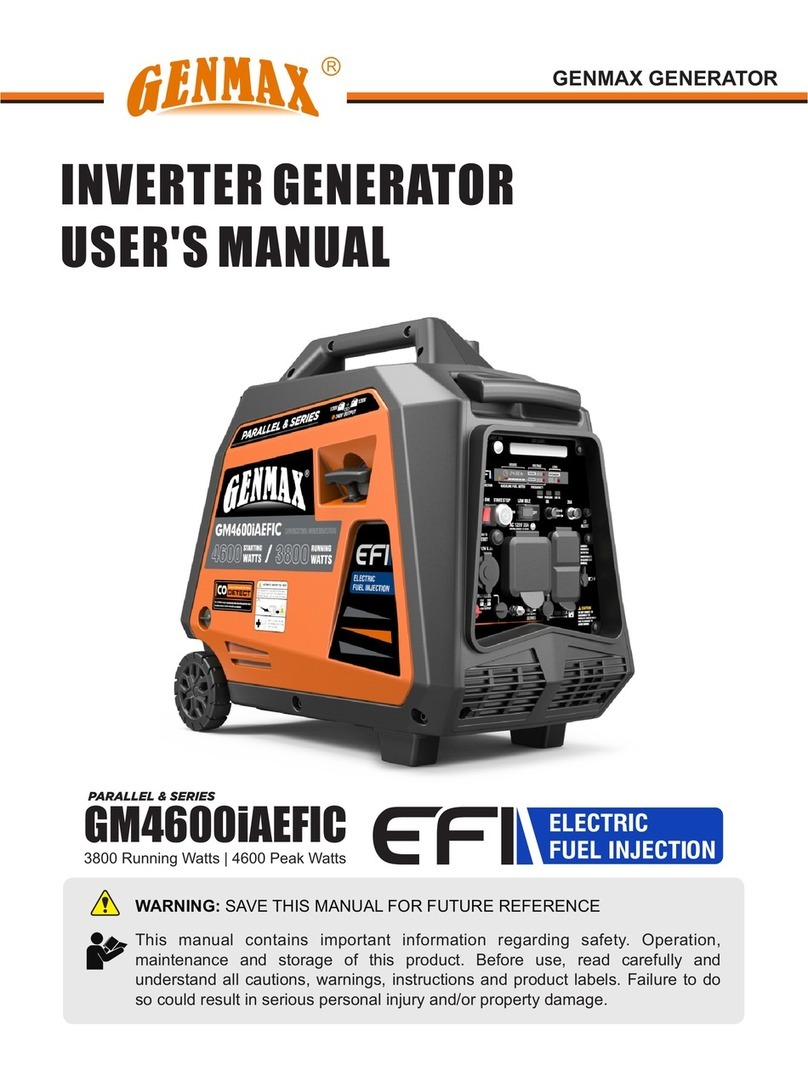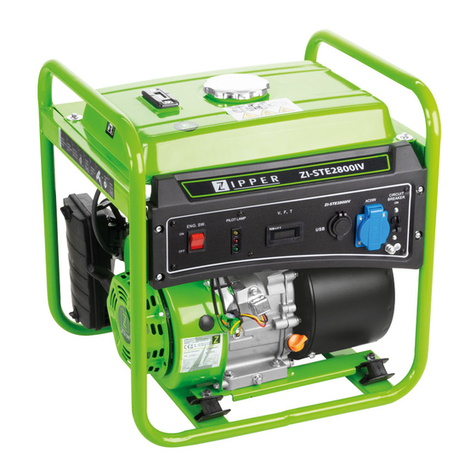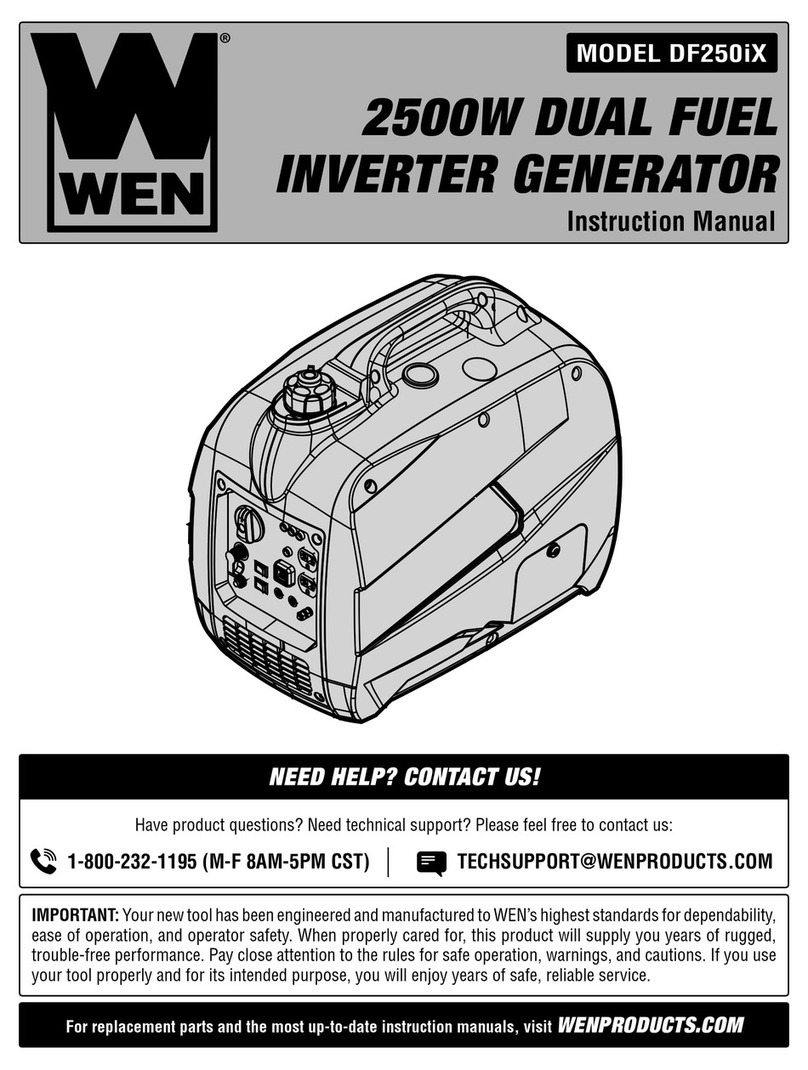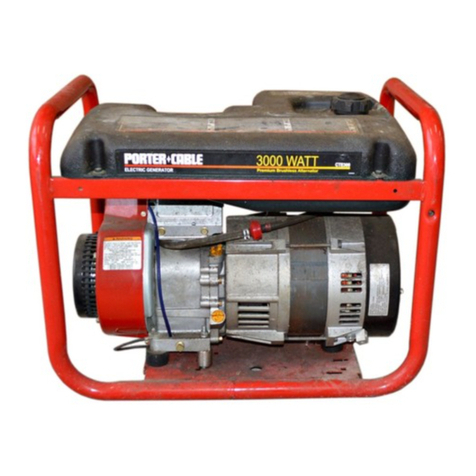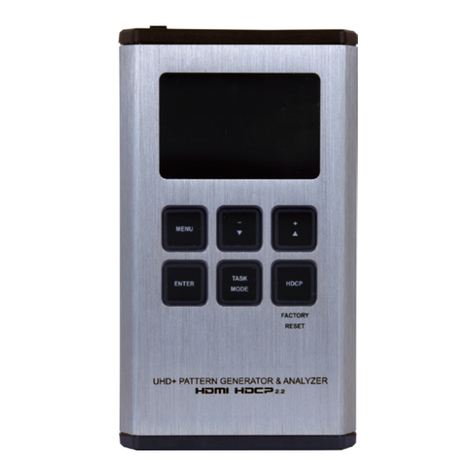Electro Adda G Series User manual

MM-12-rev 01-EN
ASYNCHRONOUS THREE-PHASE GENERATORS
G LINE
OPERATING INSTRUCTIONS

MM-13- rev 01-EN
2
GENERAL SAFETY WARNINGS...........................................................................................................................3
DESCRIPTION OF THE GENERATORS ...............................................................................................................4
GENERAL INFORMATION................................................................................................................................4
G-C LINE .............................................................................................................................................................4
G-W LINE ............................................................................................................................................................4
G-QN AND G-A LINE ...........................................................................................................................................5
GENERAL FEATURES...........................................................................................................................................7
REFERENCE STANDARDS..............................................................................................................................7
MANUFACTURING DETAILS............................................................................................................................8
Frame and stator............................................................................................................................................8
Stator winding and insulation.........................................................................................................................9
Rotor ..............................................................................................................................................................9
Non-drive end shield......................................................................................................................................9
Drive end shield/Flange.................................................................................................................................9
The drive end shield or flange is made in cast iron or steel and is fixed to the frame using high tensile
strength screws..............................................................................................................................................9
Bearings.........................................................................................................................................................9
Appropriate covers are also provided to prevent leakage of lubricant from the bearings.............................9
Line terminal box..........................................................................................................................................10
DOCUMENTATION..........................................................................................................................................13
IDENTIFICATION OF THE GENERATOR.......................................................................................................13
RECEIPT...............................................................................................................................................................14
GENERATOR HANDLING.......................................................................................................................................14
STORAGE.............................................................................................................................................................14
INSTALLATION AND COMMISSIONING ............................................................................................................15
Assembly and disassembly of the transmission component.......................................................................15
Alignment.....................................................................................................................................................16
Vertical deviation..........................................................................................................................................18
Axial displacement.......................................................................................................................................18
Electric connections.....................................................................................................................................20
OPERATION .........................................................................................................................................................22
OPERATING CONDITIONS.....................................................................................................................................22
SAFETY NOTICE..................................................................................................................................................22
CHECKS DURING OPERATION...............................................................................................................................22
Vibration check ............................................................................................................................................23
MAINTENANCE....................................................................................................................................................24
PREVENTIVE MAINTENANCE .......................................................................................................................24
GENERAL CLEANING.....................................................................................................................................25
Cleaning the windings..................................................................................................................................25
Drying the windings......................................................................................................................................25
MAINTENANCE OF THE BEARINGS..............................................................................................................26
Features of the grease.................................................................................................................................26
Changing the grease....................................................................................................................................27
Cleaning the bearings..................................................................................................................................27
Disassembly of the bearings........................................................................................................................27
Mounting the bearings .................................................................................................................................27
SPARE PARTS.....................................................................................................................................................28
Ordering spare parts....................................................................................................................................28
Storage of spare parts .................................................................................................................................28
MEASUREMENT OF INSULATION RESISTANCE.............................................................................................29

MM-13- rev 01-EN
3
GENERAL SAFETY WARNINGS
Installation, operating and maintenance of electric generators can be potentially dangerous. All
precautions and measures must therefore be taken to prevent the occurrence of such dangerous
situations.
NOTICE
Electric generators are components with dangerous parts as they are live or have parts which
move while in operation. Therefore:
incorrect use,
removal of protections without isolating the power supply,
disconnection of protection devices,
failure to perform inspections or maintenance,
may cause serious injuries to people.
In particular, maintenance interventions must be carried out exclusively by qualified staff i.e. persons
with specific knowledge, experience, appropriate professional training, knowledge of safety
regulations, standards, accident prevention provisions and working conditions. Safety managers
must authorise this staff to perform the necessary jobs and prevent any danger (also refer to IEC 364
Standard for the definition of qualified staff).
For jobs in plants with high electric currents, the access and work prohibition for unqualified staff is
ruled by the IEC 364 Standard as well.
This manual contains some of the symbols used to warn about any danger which could arise during
the various operations.
The symbols, together with relative wording “Danger”, “Caution” and “Warning” indicate the potential
risk from not complying with the prescriptions which they are coupled up with.
The following table gives the meaning of the symbols:
DANGER - RISK OF ELECTRIC SHOCK
Warning that there is a risk of electric shock if this notice is ignored
DANGER
Warning that there is a risk of serious injury if this notice is ignored
CAUTION
Warning that there is a risk of damage to persons and/or objects if this notice is
ignored
WARNING
Warning that there is a risk of damage to the generator or to the driving unit if
this notice is ignored
For reasons of general clarity, this manual does not contain all cases of operation, maintenance and
possible repairs. Therefore it mainly contains only the information required by qualified personnel
(see above) if the machines are used, as intended, as traction motors. In case of problems,
especially for more detailed information, we recommend you to always clearly indicate the machine
type and serial number.

MM-13- rev 01-EN
4
DESCRIPTION OF THE GENERATORS
GENERAL INFORMATION
The G Line asynchronous three-phase generators frame size 280÷560 described in this operating
and maintenance manual are designed in order to consider the different requirements in the field of
low voltage generation, in the range of outputs included within 150 and 2000 kW.
The series of basic machines is made up of different executions both as protection degree and
cooling type as described hereunder:
G-C Line
The G-C Line generators are of the enclosed type provided with fins, with external ventilation
(IC411) and IP54 protection degree.
This constructive solution allows to make a generator that can be installed also outdoors without any
additional protection.
G-W Line
The G-W Line generators are made with IC7A1W7 cooling system made up by a primary cooling fluid
(air) with a heat exchanger built-in in the generator frame that uses fresh water coming from a remote
circuit.

MM-13- rev 01-EN
5
The water cooling is a very efficient system to remove the heat produced by the generator. This
system allows to significantly reduce the dimensions and the weight of the generator.
The water cooling also allows to:
Reduce the heat transmitted to the room
Reduce the noise transmitted
Reduce the vibrations transmitted to the foundation
Avoid to raise dust in the room
Reduce the dimensions of the machines
G-QN and G-A Line
The G-A Line is made up by a self-ventilated generator with IP23S protection degree.
The cooling air, by means of a fan fixed directly on the generator shaft, is normally sucked on the top
and is ejected by proper grids placed on the bottom in correspondence of the coupling flange.
The G-A Line is suitable to be installed indoors.

MM-13- rev 01-EN
6
All G Line generators are designed, manufactured, assembled and tested at our works in
BEVERATE di BRIVIO - Lecco - ITALY.

MM-13- rev 01-EN
7
GENERAL FEATURES
REFERENCE STANDARDS
The G Line generators are in compliance with the following Standards:
RATINGS AND PERFORMANCES IEC 60034-1 CEI EN 60034 – 1
METHODS FOR DETERMINING LOSSES AND EFFICIENCY IEC 60034 - 2 CEI EN 60034–2
CLASSIFICATION OF DEGREES OF PROTECTION (IP CODE) IEC 60034-5 CEI EN 60034–5
METHODS OF COOLING (IC CODE) IEC 60034 - 6 CEI EN 60034–6
CLASSIFICATION OF TYPE OF CONSTRUCTION AND MOUNTING ARRANGEMENTS (IM
CODE) IEC 60034-7 CEI EN 60034–7
TERMINAL MARKINGS AND DIRECTION OF ROTATION IEC 60034-8 CEI 2-8
BUILT-IN THERMAL PROTECTIONS IEC 60034-11
MECHANICAL VIBRATIONS IEC 60034-14 CEI EN 60034–14
DIMENSIONS AND POWERS OF ELECTRIC MACHINES IEC 60072-1

MM-13- rev 01-EN
8
MANUFACTURING DETAILS
The G Line generators described in this manual have been designed and are manufactured in order
to assure the maximum operating reliability and safety.
G-C Line generators - Materials
Frame size
160 180 200 225 250 280 315 355 400 450 500 560
Frame Aluminium Steel
DE shield Cast iron Steel
NDE shield Cast iron Steel
Flange Cast iron Steel
Shaft Steel C40 ( on request 39NiCRMd4 )
Terminal box Aluminium Steel
G-W Line generators - Materials
Frame size
160 180 200 225 250 280 315 355 400 450 500 560
Frame Steel
DE shield Cast iron Steel
NDE shield Cast iron Steel
Flange Cast iron Steel
Shaft Steel C40 ( on request 39NiCRMd4 )
Terminal box Aluminium Steel
G-QN – G-A Line generators - Materials
Frame size
160 180 200 225 250 280 315 355 400 450 500 560
Frame Steel
DE shield Cast iron Steel
NDE shield Cast iron Steel
Flange Cast iron Steel
Shaft Steel C40 ( on request 39NiCRMd4 )
Terminal box Aluminium Steel
Frame and stator
The frame is the external envelope of the generator and, besides the structural function, it also
conveys the cooling fluid and the cooling air.
In the W Line generators it also acts as a heat exchanger.
The stator core complete with the windings is placed inside the frame.
The stator lamination core consists of thin thickness (0,65 mm.) magnetic laminations. Longitudinal
grooves, called slots, are made in the part of the laminations nearest to the air gap, distributed evenly
around the air gap with the winding housed inside them.
The stator slots are half-open to make it easier to insert the winding wires.
The laminations used are insulated, the ones from the others, to reduce losses from eddy currents.
The laminations of the generator core are made of low loss steel sheet alloyed with silicon, to reduce
iron losses and consequently improve the general performance of the generator.
In W Line generators, the cooling circuit of the generator itself is obtained inside the frame.

MM-13- rev 01-EN
9
Stator winding and insulation
Materials used to make the windings and the insulation system are in class H.
Stator winding is three-phase AC with coils manufactured with enamelled copper wire and positioned
in bulk in the stator slots.
The copper wire used for stator winding is insulated using enamel made with modified polyesterimide
resins plus amide-imide resins, with 200°C heat class.
Stator slots are insulated using "NOMEX” sheets
Finally, the winding is exposed to a vacuum impregnation process in autoclave using hot polimerizing
resins to guarantee further insulation and tightly gathering the bundles of copper, which are subject to
electro-dynamic stress.
Rotor
The rotor of the generator is made of a laminated core obtained with the same lamination types of
the stator core.
C Line generators up to frame size 315 and W and Q Line generators up to frame size 280, are
normally provided with rotor made with aluminium die cast cage. This solution provides an excellent
stiffness of the rotor core.
Generators in bigger frame sizes are provided with squirrel cage rotor made in copper with
rectangular section.
The bars of the cage are connected to each other by means of copper rings. These rings are welded
to the bars using a welding process in an atmosphere of inert gas.
The realization of the rotor cage made as indicated above allows to reduce the rotor losses (thanks to
reduced resistivity) and to obtain a higher efficiency and lower general heating of the machine.
Non-drive end shield
The non-drive end shield is made in cast iron or steel and is fixed to the frame using high tensile
strength screws.
In generators with vertical axis, the NDE end shield houses the thrust bearing suitable to bear the
load arising from the rotor weight or for special executions the turbine weight.
Drive end shield/Flange
The drive end shield or flange is made in cast iron or steel and is fixed to the frame using high tensile
strength screws.
Bearings
The generator is provided with grease-lubricated rolling bearings.
The shield supports have a Tecalemit-type greasing nipple to allow re-lubrication of the bearing and a
plug for the drainage of the consumed grease.
Appropriate covers are also provided to prevent leakage of lubricant from the bearings.
In generators with vertical axis, the upper bearing is able to bear the weight arising from the rotor
weight and of a normal shaft coupling.
On request the generator can be provided with upper bearing able to bear also loads arising from the
weight of the turbine impeller and from the hydraulic load.

MM-13- rev 01-EN
10
Line terminal box
The terminal block for generators frame size 250÷355 is normally provided with 6x terminals; the
terminal block for generators frame size 400÷560 is provided with 3 terminals only (one each phase),
to which the supply cables are connected.
In such case the connection of the windings is made inside the machine itself and it is not accessible.
On request, also generators frame size 400÷560 can be made with 6 terminals in order to have all
winding terminals accessible.
The terminal block is made in anti-mould non-hygroscopic material.
As mentioned, the terminal box (in aluminum alloy for the generators frame size 250÷355 and in steel
plate for bigger frame sizes) has IP 55 or IP 56 protection degree, provided that the connection of the
supply cables is properly made.
Dimensions of terminal box and block for generators frame size 250 ÷ 355
TIPO PRESSACAVO
Type A B C D E F Cable Gland
160 - 180 188 86 82 52 M8 30 M40x1.5
200LT 188 86 95 60 M8 35 M40x1.5
200 - 225 225 103 95 60 M10 35 M50x1.5
250MT 225 103 115 70 M10 45 M50x1.5
280ST-MT 276 120 125 80 M12 45 M50x1.5
315 375 145 145 90 M14 54 N.2 M63x1.5
355 L - Lx 430 165 165 100 M16 65 N.2 M63x1.5
Dimensions of terminal box and block for generators frame size 400 ÷ 560
Generators frame size 400÷560 are provided with steel terminal box and, as mentioned, they can be
provided with 3 or 6 terminals. Terminal boxes are supplied with a removable plate for the cable exit
to be drilled by the customer.

MM-13- rev 01-EN
11
Terminal block with 3 terminals
Terminal block with 6 terminals provided with no. 3 copper plates

MM-13- rev 01-EN
12
Auxiliary terminal box
Generators are prepared for fitting auxiliary terminal boxes with IP55 or IP56 protection degree.
Inside the terminal boxes are placed the electrical connections of any possible accessories such as
thermal protectors, thermal detectors, heaters, encoder, etc.
The auxiliary terminal boxes are of 3 types depending on the size of the generator and the number of
electric connections required by the Customer and can be in aluminium (up to frame size 355) or in
steel (generators frame size 400÷560).
Hereunder are mentioned the overall dimensions:
Aluminium auxiliary terminal box for generators
frame size 250÷315
Aluminium auxiliary terminal box for generators
frame size 355
Steel auxiliary terminal box for generators frame size 400÷560

MM-13- rev 01-EN
13
DOCUMENTATION
The documentation concerning the generator specifications and the operating and maintenance
manuals are supplied to the customer who places the order.
You can contact Electro Adda SpA to obtain further copies of these documents.
In addition to this manual, each machine is provided with the following documents:
Data sheet containing the electromechanical details
Overall dimensions drawing
Weight and loads of the generator on the foundation
Electrical connection diagram
Instruments and position of accessories
Upon customer request it is possible to issue an additional documentation containing items not
included in this manual.
In case of conflict between this manual and the additional documentation of the machine, the
additional documentation will prevail.
IDENTIFICATION OF THE GENERATOR
A plate containing rating data as well as electro mechanical data is fixed to the generator frame. This
plate must never be removed from the generator.
This plate also contains the serial number assigned by Electro Adda SpA. This serial number enables
the complete generator tracking.
Upon customer request special plates mentioning particular features can be added. For example:
system item etc.

MM-13- rev 01-EN
14
RECEIPT
The generator is delivered complete with all parts, ready for installation, after the prescribed quality
controls during the production cycle and a final inspection to check correspondence to the project
specifications.
On receipt, it is advisable to examine the generator to verify that no damage during transport
occurred.
Any damage that might be detected, must be immediately reported to the forwarder and to
ELECTRO ADDA S.p.A.
Generator handling
To unload the generator and to handle it, it is necessary to pay particular attention to avoid injuries to
the persons in charge and to avoid any damage to the generator.
Before lifting the machine, make sure that the lifting equipment is available and that the personnel is
familiar with this type of operation. The weight of the machine is shown on the rating plate, on the
dimensional drawing and on the delivery note.
.
STORAGE
If the generator must be stored for a long period of time, several precautions must be taken to
prevent its deterioration.
If possible, the machine must be placed in a covered, clean and dry place.
The temperature of the rooms where generators are stored, should be included within 10°C and
50°C.
In case generators should be stored in heavier conditions, it is necessary to consult Electro Adda
SpA Technical Department when placing the order.
The storage place should possibly have a low humidity level (Relative humidity below 75%).
If the generator is provided with anti-condensation heaters, it is convenient to connect them and to
occasionally check their good operation.
If the machine has to be stored outdoors, it is advisable to protect it with proper covers which prevent
water inlet but at the same time allow ventilation of the machine. If the generator is protected with
plastic wrapping, it is advisable to make some holes in the wrapping to allow ventilation.
If the storage period is extended, the generator must be inspected frequently and the insulation
resistance of the windings must be controlled at regular intervals. The procedure to check insulation
resistance is described in enclosure 1 of this manual.
Whenever a significant reduction in the resistance value is detected, the cause must be investigated
and a solution found for the problem.

MM-13- rev 01-EN
15
INSTALLATION AND COMMISSIONING
The generator must be installed in a well ventilated place. Avoid the proximity of walls or other
machinery as they might obstruct normal ventilation.
The machine foundation must be flat, stiff, strong and suitable to withstand the weight of the machine
and the other electrodynamic forces mentioned in the overall dimensions drawing.
The holes for the machine fixing screws are situated on the feet of the frame for generators in
mounting B3 and on the DE flange for generators in mounting B5.
The following table shows the tightening torque of the foundation bolts.
Nm Pound foot
Bolt
dimensions Lubricated Dry [Nm] Lubricated Dry
M8 32 24 35 26
M10 62 46 67 49
M12 75 55 80 59
M13 120 88 130 96
M16 180 130 200 150
M 20 350 380 260 280
M 24 600 650 430 470
M 27 900 970 660 700
M 30 1200 1300 890 960
M 36 2100 2300 1500 1700
Tightening torque in Nm (pound foot) Bolts Class 8.8
Assembly and disassembly of the transmission component
The use of a flexible coupling is advisable for the mechanical connection of the generator. This must
be able to prevent the transmission of any axial or radial thrust to the bearings.
Normally the coupled machine must not transmit torsional vibrations to the generator shaft.
In the case of direct coupling it is necessary to pay particular attention to the generator alignment.
Any vibrations and operation irregularities are a sign of imprecise alignment. In this case it is
necessary to perform alignment with higher accuracy.
The generator rotor has been dynamically balanced with half key applied to the shaft extension.
To prevent vibrations during operation it is also necessary that the transmission component (coupling
half) is accurately balanced, with half key in the corresponding keyway, before being fitted onto the
shaft extension.
The transmission component must be shrink fitted according to the manufacturer’s instructions.
For more common applications and normal couplings it is possible to establish the following
tolerances for the execution of the hole in coupling half:

MM-13- rev 01-EN
16
F
DGA
Tolerances
D : H7
F : P9
GA : +0.4 - +0.6 mm
Do not use hammers or mallets to fit the transmission component. Before heating the coupling half
any non-metal parts must be disassembled as they might be damaged by the heat.
The coupling half must also only be removed after it has been heated using a flame or an electric
induction appliance. It is advisable to use a proper extractor.
It is possible to find equipment on the market for the disassembly of coupling halves. These allow
disassembly without heating the coupling half, using pressurised oil. In this case the coupling halves
must be already prepared before assembly.
Alignment
The generator must always be well-aligned, most of all if coupled directly to the driving machine.
Incorrect alignment is a source of vibrations, which may lead to bearing, support and shaft damage.
To obtain precise alignment, it is necessary to use a metal ruler and a thickness gauge or
alternatively one or two comparators.
After having mounted the two coupling halves onto the coupled machine and its generator and after
having positioned the two machines, having taken the precaution to leave the distance indicated on
the overall dimensions drawing between the two coupling halves, it is necessary to slightly tighten the
flange fixing screws and carry out a first rough alignment.
Rest the ruler on the two coupling halves and measure the radial alignment.
Repeat the measurement in the positions at 90°, 180° and 270° after having turned the two shafts
together:
Insert a thickness gauge between the faces of the coupling halves and measure their axial distance.
Repeat the measurement in the various positions at 90°, 180° and 270° after having turned the two
shafts together.
The difference between the measurements must be lower than 0.05 mm.
The maximum alignment errors must be within the values indicated below:
(x = distance defined for the type of coupling half used)

MM-13- rev 01-EN
17
:X
a
b
C
a = X/2 5 b = ± 0.05 c = ± 0.05
Whenever the alignment errors exceed the tolerated values, the appropriate corrections must be
performed by means of shims inserted under the machine flange and, if necessary, with small lateral
movements.
After having fully tightened the bolts, the measurement must be repeated and, if alignment is precise,
the reference pins can be applied between the machine and the rest surface.
Further refinement of alignment can be obtained using two comparators, each joined to a coupling
half, which measure axial and radial oscillations in the different positions.
If the coupled machine works at temperatures higher than those of the generator, in the alignment
phase, it is necessary to compensate the differences that can be determined by the different
expansions.
The suppliers of the coupled machines must supply the values of the vertical, lateral and axial
deviations to normal operation temperatures.

MM-13- rev 01-EN
18
Vertical deviation
By heating the generator, the distance between the foot of the generator and the center of the shaft
(frame size) increases. This increase is mentioned in the following table:
Frame size Increase in mm
160÷200 0.1
225÷250 0.13
280 0.15
315 0.16
355 0.18
400 0.2
450 0.23
500 0.25
560 0.28
Axial displacement
The axial displacement needs to be considered when, in case of generator with horizontal axis (as it
usually occurs), the non-drive end bearing is locked, or in case of generator with vertical axis, in
which the thrust bearing is always on the top and therefore the shaft can lengthen downwards.
The maximum elongation of the shaft is proportional to the length of the shaft and can be obtained
from the following table:
Frame size Increase in mm
160÷200 0.4
225÷250 0.6
280 0.8
315 1
355 1.1
400 1.2
450 1.2
500 1.3
560 1.5
NOTE: Make sure that between the coupling halves (excluding rigid couplings) the axial movement is
free and continuous in order to permit expansion, in case the runner is connected directly on the
generator shaft, it is necessary to verify that the above mentioned axial displacement is possible.
Mechanical connections (G-N Line generators)
Machines with cooling airflow to and/or from the machine with air ducts are provided with connection
flanges as specified in the dimensional drawing.
Carefully clean the air ducts before connecting them to the machine and check if there are any
obstructions in the ducts. Seal the joints with appropriate gaskets and check for possible leaks in the
air ducts after they have been connected.

MM-13- rev 01-EN
19
Hydraulic connections (G-W Line generators)
Water cooled machines are normally equipped with threaded connections for the water inlet and
outlet or, on request, with flanges.
The following table shows the cooling water flow rate values and the dimensions of the pipes
normally used.
Frame size Flow rate
Litres/min Sleeve thread
200÷225 8 3/4 gas
250 10 3/4 gas
280 15 1 gas
315 20 1 1/4 gas
355 25 1 1/4 gas
400 30 1 1/4 gas
450 35 1 1/2 gas
500 40 1 1/2 gas
560 50 2 gas
Connect the water pipes and seal the joints using the proper gaskets.
Remember to open the cooling water circuit before starting the
machine.
The cooling circuit of G-W Line generators is made with carbon steel which is subject to corrosion in
the presence of saline or foul water, therefore it must be used only with closed water circuit with
purified water.
Standard values for the cooling water to be used in the cooling system:
pH 6.0 - 8.0
Alkalinity (CaCO3) > 1 mmol/kg
Chloride (Cl) < 20 mg/kg
Sulphate < 100 mg/kg
KMnO4 concentration < 20 mg/kg
Al concentration < 0,3 mg/kg
Mn concentration < 0,05 mg/kg
The normal tap water fulfils the above values.
The cooling water must also be inhibited with an agent protecting the system against corrosion,
fouling and when necessary, against freezing. All materials which may be in touch with the cooling
water (pipes, heat exchanger, etc.) must be considered when selecting a suitable inhibitor.
It is recommended to use suitable and high-quality connection components to carry out the cooling
circuit.
Before commissioning the generator check if there are any leaks after the pipes and joints have been
connected.
Corrosion products and fouling deposits may cause a reduction in the thermal exchange or obstruct
the cooling circuit; consequently it is extremely important to use purified and inhibited water.

MM-13- rev 01-EN
20
Assembling of the vibration transducers (SPM) ( if provided)
Vibration transducers are normally supplied disassembled in order to avoid having them damaged
during transport.
To install transducers it is necessary to refer to the instructions supplied by the transducer
manufacturer.
Electric connections
CAUTION
It is important to verify that the supply voltage and the frequency correspond to the values
indicated on the rating plate fixed on the machine.
Before starting the installation work, it is important to check that the incoming cables are
separated from the supply mains, and that the cables are connected to the protective earth.
Check all rating plate data, especially the voltage and winding connection.
Any work on the electric installation must be carried out only by skilled personnel.
The following safety rules must be applied:
De-energize all equipment, including auxiliary equipment
Provide safety protections to avoid re-energizing of the equipment
Verify that all components are isolated from their respective supply
Connect all parts to protective earth and to short circuits
Cover or provide barriers against live parts in the surrounding area
Main terminal box
The winding terminals are places inside the main terminal box.
Generators in standard execution are made with 3 terminals only. In some types with star connection,
an accessible “star point” is provided.
Direction of rotation is clockwise seen from the drive end when the phase sequence L1, L2, L3 is
connected to the terminals U1 V1 V2.
To reverse the direction of rotation, exchange the connection of two of the terminals.
The dimension of the incoming cables must be suitable for the maximum load current and in
accordance with the applicable rules.
CabIe terminals must be of the appropriate type and have the right dimensions.
In order to assure a reliable operation, power cable connections must be properly tightened.
Supply cables must be suitably held in order not to cause stresses on the terminal boards.
The inside of the main terminal box must be free from dirt, humidity and foreign residues. The box
itself, the cable glands, and unused cable entrance holes must be hermetically sealed against dust
and water.
Auxiliary terminal box (if provided)
Auxiliary terminal boxes are fixed to the frame of the generator according to the accessories and to
the customer’s requirements.
Their position is shown on the overall dimensions drawing.
Auxiliary terminal boxes are provided with terminal blocks and cable glands, as shown in the drawing
hereunder. The maximum dimensions permitted for the conductors are normally
limited to 2.5 mm² for signal conductors and to 4 mm² for auxiliary power circuits and the voltage is
limited to 750 V.
This manual suits for next models
3
Table of contents

